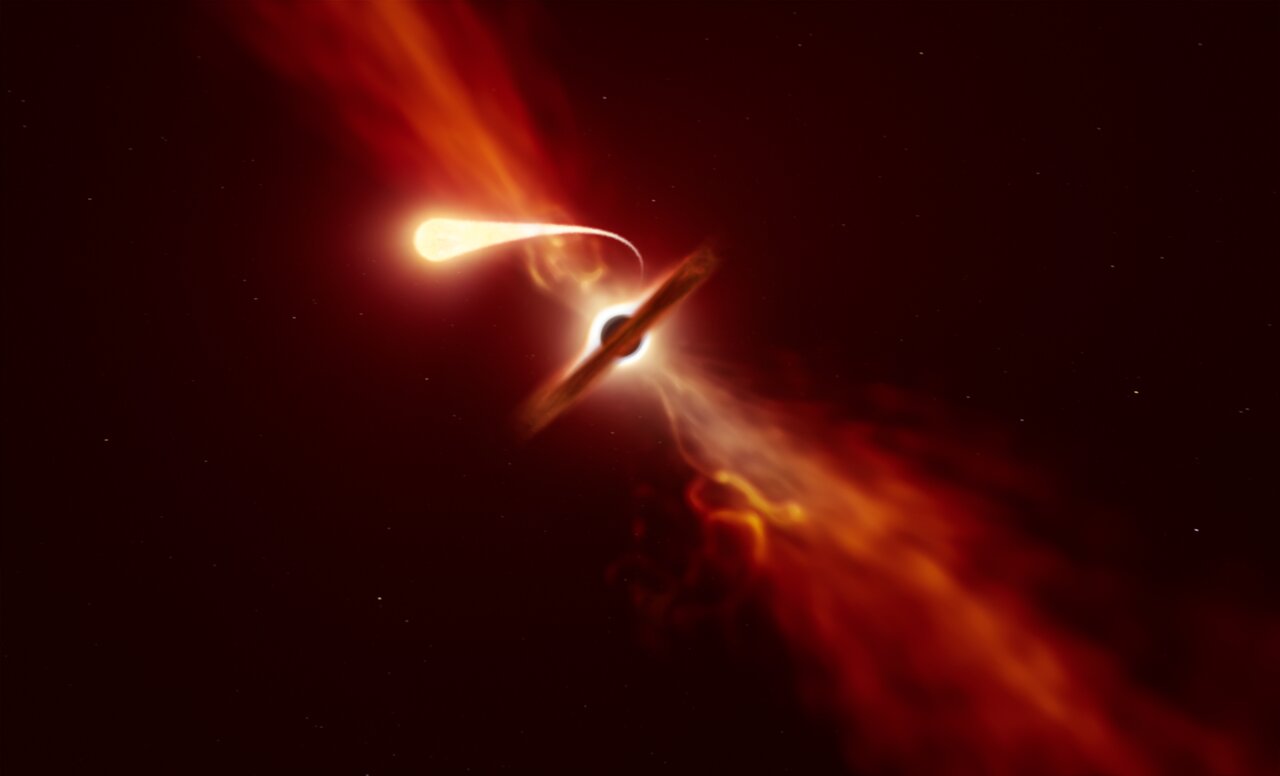Massive black hole turns star in solar size into spaghetti
About 215 million years ago the fate of a star was fulfilled: It was swallowed by a black hole with a million solar masses. The death struggle dragged on for a whole month. Meanwhile, the dying star was bidding farewell, a high-energy flare that emitted enough energy in the X-ray range alone to accelerate the Earth to one percent of the speed of light.
This flare, called AT2019qiz and registered on Earth in 2019, was a gift to terrestrial astronomers. It is the first star death of this kind that was discovered so close to the Earth (although 215 million light years are not «around the corner»). This made it possible to record the event with many telescopes worldwide. The results have now been published in the Monthly Notices of the Royal Astronomical Society.
Astronomers were able to clearly identify AT2019qiz as a tidal disruption event – an event in which an object is ruptured by the enormous gravitational pull of a black hole. «The idea that a black hole ‘sucks’ a nearby star sounds like science fiction. But that’s exactly what happens in a tidal distruption event,» says Matt Nicholl, lecturer and research fellow of the Royal Astronomical Society at the University of Birmingham, UK, and lead author of the new study. But these events, in which a star experiences what is known as spaghettification when it is sucked in by a black hole, are rare and not always easy to study. The research team aimed ESO’s Very Large Telescope (VLT) and ESO’s New Technology Telescope (NTT) at a new flash of light that occurred last year near a supermassive black hole to study in detail what happens when a star is sucked up by such a monster.
Astronomers know what should theoretically happen. «When an unfortunate star moves too close to a supermassive black hole at the center of a galaxy, the black hole’s extreme gravitational pull rips the star into thin streams of matter,» explains study author Thomas Wevers, an ESO fellow in Santiago, Chile, who was at the Institute of Astronomy at the University of Cambridge, UK, when he conducted the work. When some of the thin strands of stellar material fall into the black hole during this spaghetti formation process, a bright burst of energy is released, which astronomers can detect.
Although they are strong and bright, astronomers have had difficulty in studying this flash of light, which is often obscured by a curtain of dust and debris. Only now have astronomers succeeded in illuminating the origin of this curtain. «We have found that when a black hole swallows up a star, it can send out a strong burst of material that obstructs our vision,» explains Samantha Oates, also at the University of Birmingham. This is because the energy released when the black hole eats up stellar material drives the star’s debris outward.
The discovery was possible because the AT2019qiz team found AT2019qiz only a short time after the star was torn apart. «So we were actually able to see the curtain of dust and debris lift as the black hole unleashed a powerful outflow of material at speeds of up to 10,000 km/s,» says Kate Alexander, a NASA Einstein fellow at Northwestern University in the United States. «This unique ‘look behind the curtain’ provided the first opportunity to locate the origin of the obscuring material and to follow in real time how it swallows the black hole.
The team conducted observations of AT2019qiz, located in a spiral galaxy in the constellation of Eridanus, over a period of six months as the flare gained in luminosity and then faded. The prompt and extensive observations in ultraviolet, optical, X-ray and radio light showed for the first time a direct connection between the material emanating from the star and the bright flare emitted as it is engulfed by the black hole. «The observations showed that the star had about the same mass as our own Sun and that it lost about half of that mass to the monster Black Hole, which is over a million times more massive,» says Nicholl, who is also a visiting researcher at the University of Edinburgh.
The research helps us to better understand supermassive black holes and how matter behaves in the environments with extreme gravity around them. According to the team, AT2019qiz could even serve as a «Rosetta stone» for interpreting future observations of disruption events. ESO’s Extremely Large Telescope (ELT), which is scheduled to be operational within the next decade, will enable researchers to detect events that are becoming fainter and faster in order to solve further puzzles in black hole physics.
